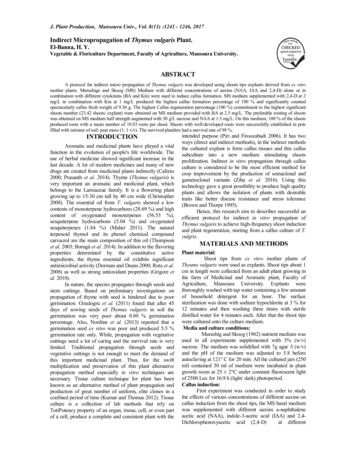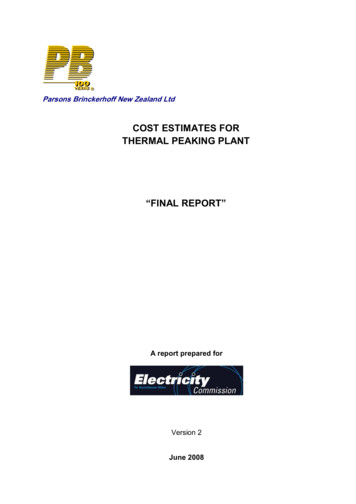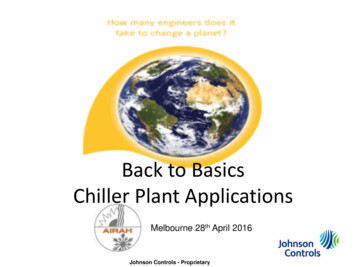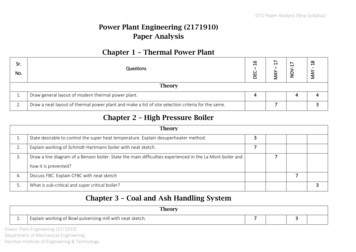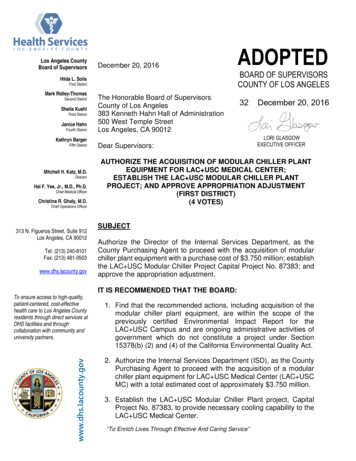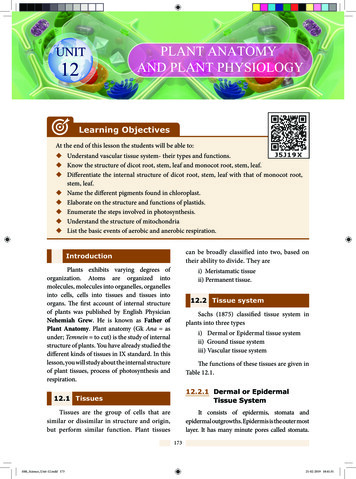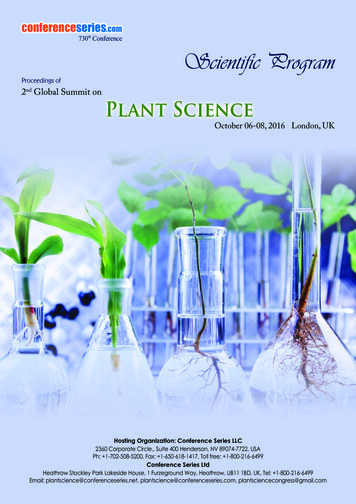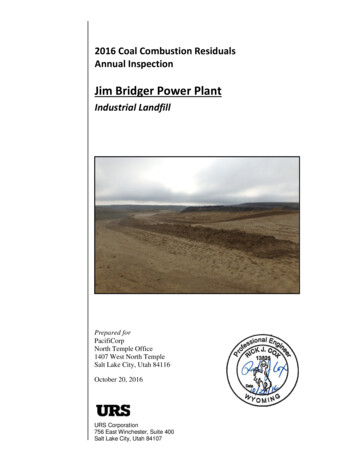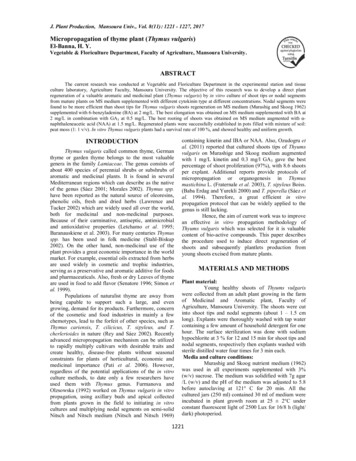
Transcription
J. Plant Production, Mansoura Univ., Vol. 8(11): 1221 - 1227, 2017Micropropagation of thyme plant (Thymus vulgaris)El-Banna, H. Y.Vegetable & Floriculture Department, Faculty of Agriculture, Mansoura University.ABSTRACTThe current research was conducted at Vegetable and Floriculture Department in the experimental station and tissueculture laboratory, Agriculture Faculty, Mansoura University. The objective of this research was to develop a direct plantregeneration of a valuable aromatic and medicinal plant (Thymus vulgaris) by in vitro culture of shoot tips or nodal segmentsfrom mature plants on MS medium supplemented with different cytokinin type at different concentrations. Nodal segments werefound to be more efficient than shoot tips for Thymus vulgaris shoots regeneration on MS medium (Murashig and Skoog 1962)supplemented with 6-benzyladenine (BA) at 2 mg/L. The best elongation was obtained on MS medium supplemented with BA at2 mg/L in combination with GA3 at 0.5 mg/L. The best rooting of shoots was obtained on MS medium augmented with αnaphthaleneacetic acid (NAA) at 1.5 mg/L. Regenerated plants were successfully established in pots filled with mixture of soil:peat moss (1: 1 v/v). In vitro Thymus vulgaris plants had a survival rate of 100 %, and showed healthy and uniform growth.INTRODUCTIONThymus vulgaris called common thyme, Germanthyme or garden thyme belongs to the most valuablegenera in the family Lamiaceae. The genus consists ofabout 400 species of perennial shrubs or subshrubs ofaromatic and medicinal plants. It is found in severalMediterranean regions which can describe as the nativeof the genus (Sáez 2001; Morales 2002). Thymus spp.have been reported as the natural source of oleoresins,phenolic oils, fresh and dried herbs (Lawrence andTucker 2002) which are widely used all over the world,both for medicinal and non-medicinal purposes.Because of their carminative, antiseptic, antimicrobialand antioxidative properties (Letchamo et al. 1995;Baranauskiene et al. 2003). For many centuries Thymusspp. has been used in folk medicine (Stahl-Biskup2002). On the other hand, non-medicinal use of theplant provides a great economic importance in the worldmarket. For example, essential oils extracted from herbsare used widely in cosmetic and trophic industries,serving as a preservative and aromatic additive for foodsand pharmaceuticals. Also, fresh or dry Leaves of thymeare used in food to add flavor (Senatore 1996; Simon etal. 1999).Populations of naturalist thyme are away frombeing capable to support such a large, and evengrowing, demand for its products. Furthermore, concernof the cosmetic and food industries in mainly a fewchemotypes, lead to the forfeit of other species, such asThymus cariensis, T. cilicicus, T. sipyleus, and T.cherlerioides in nature (Rey and Sáez 2002). Recentlyadvanced micropropagation mechanism can be utilizedto rapidly multiply cultivars with desirable traits andcreate healthy, disease-free plants without seasonalconstraints for plants of horticultural, economic andmedicinal importance (Pati et al. 2006). However,regardless of the potential applications of the in vitroculture methods, to date only a few researchers haveused them with Thymus genus. Furmanova andOlzsowska (1992) worked on Thymus vulgaris in vitropropagation, using axillary buds and apical collectedfrom plants grown in the field to initiating in vitrocultures and multiplying nodal segments on semi-solidNitsch and Nitsch medium (Nitsch and Nitsch 1969)containing kinetin and IBA or NAA. Also, Ozudogru etal. (2011) reported that cultured shoots tips of Thyumsvulgaris on Murashige and Skoog medium augmentedwith 1 mg/L kinetin and 0.3 mg/l GA3 gave the bestpercentage of shoot proliferation (97%), with 8.6 shootsper explant. Additional reports provide protocols ofmicropropagation or organogenesis in Thymusmastichina L. (Fraternale et al. 2003), T. sipyleus Boiss.(Baba Erdag and Yurekli 2000) and T. piperella (Sáez etal. 1994). Therefore, a great efficient in vitropropagation protocol that can be widely applied to thegenus is still lacking.Hence, the aim of current work was to improvean effective in vitro propagation methodology ofThyums vulgaris which was selected for it is valuablecontent of bio-active compounds. This paper describesthe procedure used to induce direct regeneration ofshoots and subsequently plantlets production fromyoung shoots excised from mature plants.MATERIALS AND METHODSPlant material:Young healthy shoots of Thyums vulgariswere collected from an adult plant growing in the farmof Medicinal and Aromatic plant, Faculty ofAgriculture, Mansoura University. The shoots were cutinto shoot tips and nodal segments (about 1 – 1.5 cmlong). Explants were thoroughly washed with tap watercontaining a few amount of household detergent for onehour. The surface sterilization was done with sodiumhypochlorite at 3 % for 12 and 15 min for shoot tips andnodal segments, respectively then explants washed withsterile distilled water four times for 3 min each.Media and culture conditions:Murashig and Skoog nutrient medium (1962)was used in all experiments supplemented with 3%(w/v) sucrose. The medium was solidified with 7g agar/L (w/v) and the pH of the medium was adjusted to 5.8before autoclaving at 121 C for 20 min. All thecultured jars (250 ml) contained 30 ml of medium wereincubated in plant growth room at 25 2 C underconstant fluorescent light of 2500 Lux for 16/8 h (light/dark) photoperiod.1221
El-Banna, H. Y.Stage I: Growth and in vitro multiplication.Experiment 1: Effect of explants type and cytokinintype on multiplication rate.To investigate the effect of the two types ofexplant (shoot tips and nodal segments) on theproduction of multiple shoots, the surface sterilizedshoot tips and nodal segments were cultured onMurashig and Skoog medium (MS) supplemented with0.5, 1.0, 2.0 and 3.0 mg/L 6-benzyladenine enine (2iP). After 30 day of culture, datawere recorded on shoot proliferation. A factorialexperiment in a randomized complete block design wasused with 4 replicates included 12 jars for eachtreatment.Experiment 2: Shoot elongation.In vivo shoots were collected from an adult plantand cut into pieces containing a single node (about 11.5 cm) and were cultured on MS mediumsupplemented with BA (6-benzyladenine) at 2 mg/L incombination with varied concentration of GA3 at 0.25,0.50 and 1.00 mg/L. After 30 day of culture, data wererecorded on shoot proliferation. A completelyrandomized design was used with 4 replicates included12 jars for each treatment.Stage II: Induction of rooting and acclimatization.For root induction, individual in vitro raisedmicro-shoots (3 – 4 cm long) were excised from 4weeks old shoot clusters and transferred to MS basalmedium full strength supplemented with different auxintypes, i.e., indole-3-butyric acid (IBA), a-naphthaleneacetic acid (NAA) or indole-3-acetic acid (IAA) atvarious concentrations 0.0, 0.25, 0.5, 1 and 1.5 mg/L. Acompletely randomized design was used with 4replicates included 12 jars for each treatment.Micropropagated plantlets were getting out from themedium, washed under tap water to remove all traces ofmedia and then single plants were relocated to plasticpots filled with soil: peat moss (1: 1 v/v).Statistical analysis:Data of all experiments were subjected toanalysis of variance (ANOVA) by the general linearmodels (GLMs) procedure using (SAS) StatisticalAnalysis System (2000). Mean comparisons wereperformed using the least significant difference (LSD)method according to (Gomez and Gomez, 1984). Asignificance level of 5 % was used for all statisticalanalyses.RESULTS AND DISCUSSIONI- Multiplication stage:1- Effect of explants type and cytokinin type atdifferent concentrations on shoot formation ofThymus vulgaris.This experiment was conducted to test the effectof explant type, different cytokinin (BA, Kin, TDZ and2ip) at various concentrations 0.5, 1.0, 2.0 and 3.0mg/L) as well as their interactions on shootingpercentage, shoots number per explant and shoot lengthof thyme shoots. The results were recorded after 4weeks of culture on MS medium and are shown inTables (1, 2 and 3).Effect of explant type (A) on shooting behavior:Concerning the effect of explant type on shootingpercentage, shoots number and length, data in Tables (1,2 and 3) clearly indicated that nodal segments gave thehighest shooting percentage (70.8 %), shoots numberper explant (5.06 shoots) along with the highest shootlength of 1.60 cm.Effect of cytokinin type (B) on shooting behavior:Regarding the effect of cytokinin type onshooting percentage as shown in Table (1), of the fourcytokinins tested, BA was most effective in inducingbud break. The highest recorded percentage of 71.9 %was obtained with BA followed with 69.8 % for Kinwithout significant difference. The lowest value ofshooting percentage (45.8 %) was obtained with TDZ.Table 1. Effect of explant type, cytokinin type, concentrations and their interactions on response (%) ofThymus vulgaris.Explant type(A)Shoot tipCytokinin type(B)BAKinTDZ2ipMean of ( A C)Nodal segmentBAKinTDZ2ipMean of (A C)Mean of (B C)Mean of 6.762.550.070.845.862.5Cytokinin conc.(mg/L) 2Mean of(A)Mean of (B)71.956.269.845.870.866.7LSD at 5%A11.1B24.4C14.4AB25.8AC 16.8BC 33.3ABC 36.7Mean of(A B)60.462.541.760.483.377.150.072.9
J. Plant Production, Mansoura Univ., Vol. 8(11), November, 2017Concerning the effect of cytokinin type on shootsnumber per explant and shoot length, the highest valueof shoots number (5.59 shoot/ explant) was obtainedwhen MS medium was supplemented with BA, whilethe highest value of the shoot length (1.92 cm) wasrecorded with Kin (Tables 2 and 3).Effect of cytokinin concentration (C) on shootingbehavior:Regarding the effect of cytokinin concentrationon shooting percentage as shown in Table (1), theobtained results showed a positive relationship betweencytokinin concentrations and shooting percentage, itwas noticed that every increase in cytokininconcentrations from 0.5 mg/L up to 2.0 mg/L graduallyincreased shooting percentage. The highest recordedpercentage (71.9 %) was obtained with cytokinin at 2.0mg/L and increasing cytokinin concentration to 3 mg/Lsignificantly reduced shooting percentage to 55.2 %Concerning the effect of cytokinin concentrationon shoots number per explant and shoot length, thehighest value of shoots number (4.81 shoots/ explant)and shoot length (1.62 cm) was obtained when MSmedium was supplemented with cytokinin at 2.0 mg/L(Tables 2 and 3).Table 2. Effect of explant type, cytokinin type, concentrations and their interactions on shoot numberformation of Thymus vulgaris.Cytokinin conc.Mean ofMean ofExplant type Cytokinin type(mg/L) (C)Mean of (A)(B)(B)(A 2.753.123.455.59Shoot .663.03Mean of ( A 17.625.414.125.845.06Nodal .714.11Mean of (A C)4.575.605.814.25LSD at ean of (B C)TDZ2.833.313.121.54C0.242ip3.063.504.543.19AB 0.41AC 0.38Mean of (C)3.804.514.813.39BC 0.48ABC 0.71Table 3. Effect of explant type, cytokinin type, concentrations and their interactions on shoot length (cm)formation of Thymus vulgaris.Explant type(A)Cytokinin type(B)Shoot tipBAKinTDZ2ipMean of ( A C)Nodal segmentBAKinTDZ2ipMean of (A C)Mean of (B C)Mean of .791.431.051.740.591.611.25Cytokinin conc.(mg/L) 82.350.791.121.951.691.521.62Mean of (A) Mean of 1.710.591.381.301.341.241.920.771.601.66LSD at 5%A0.11B0.07C0.07AB 0.12AC 0.12BC 0.13ABCMean of(A B)1.211.550.711.491.472.290.831.830.203), the interaction between nodal segments andEffect of the interaction on shooting behavior:Concerning the interaction between explant type cytokinin type showed a highly significant differencesand cytokinin type (A B), as shown in Tables (1, 2 and in all cases. The best significant interaction effect onshooting percentage and shoots number per explant was1223
El-Banna, H. Y.achieved when nodal segments was cultured on MSmedium supplemented with BA, while the highest valueof shoot length was recorded with nodal segments andKin.It appeared from the interaction between explanttype and cytokinin concentrations (A C) as showndata in the Table (1) that the highest percentage ofshooting (81.2 %) was recorded with the interaction ofnodal segments and cytokinin concentration at 2 mg/L.Also, culturing the shoot tips on the MS mediumcontaining 3 mg/L of cytokinin produced precisely thelowest values of shooting percentage (47.9 %) whencompared with the other treatments.Concerning the interaction between explant typeand cytokinin concentrations, the obtained results inTables (2 and 3) showed that the highest significantvalues of shoots number per explant (5.81 shoots/explant) and shoot length (1.83 cm) were achievedwhen the nodal segments were cultured on MSmedium supplemented with 2 mg/L of cytokinin. Onthe other hand, the weakest interaction effect wasrecorded when shoot tips were cultured on MScontaining 3 mg/L of cytokinin, since they were 2.53shoots and 1.08 cm, respectively.Regarding the interaction between the cytokinintype and cytokinin concentrations (B C), data in TableA(1) showed that no significant effect was detected onshooting percentage. The highest record of shootingpercentage (87.5 %) was achieved when MS mediumsupplemented with BA at 2 mg/L or Kin at 1 mg/L.Concerning the effect of this interaction onshoots number per explant and shoot length (Tables 2and 3), the highest significant shoots number perexplant was recorded with MS medium supplementedwith BA at 2 mg/L (7.48 shoots) while the tallest shootlength (2.35 cm) was obtained with Kin at 2 mg/L.As for the interaction among explant type,cytokinin type and cytokinin concentration (A B C)on shooting percentage, data presented in Table (1)showed that shooting percentage of 100 % wasobtained when nodal segments were cultured on MSmedium supplemented with BA at 2 mg/LConcerning the effect of this interaction onshoots number per explant (Table 2), it was found thatnodal segments cultured on MS medium supplementedwith BA at 2 mg/L significantly produced the highestsignificant value of 9.66 shoots per explant as shown inFig. 1A. As for shoot length, data in Table (3) showedthat the highest shoot length (2.80 cm) was recordedwith nodal segments cultured on MS mediasupplemented with Kin at 2 mg/L.CBFigure 1. In vitro propagation of Thymus vulgaris. A) Multiple shoots, obtained by culturing nodal segmentson MS medium supplemented with 2 mg/L of BA. B) Elongated shoots on MS medium with BA at 2mg/L and GA3 at 0.5 mg/L. C) Rooted shoots on MS medium supplemented with NAA at 1.5 mg/L.Following these results, the strength of T.vulgaris explants to compose new shoots varied with theexplant type and hormones. In this work, the mosteffective explant type in shoot formation was found tobe nodal segments. Similar results on different plantswere obtained by Arikat et al (2004), Zuzarte et al.(2010) and Aicha et al. (2013) whom showed that nodalsegments explants gave better results than the apicalexplants in micropropagated plants of Thymus hyemalis.The different responses of both types of explant wereprobably due to the endogenous hormone balance in theplant tissue Grattapaglia and Machado (1998).Results obtained clearly indicated that Shootsnumber was affected by application of cytokinin typeand concentration to the nutrient medium, since BA at 2mg/L gave the highest significant shoots number perexplant compared to Kin, TDZ and 2ip. These resultsare in general agreement with Coelho et al. (2012),Fraternale et al. (2003) and Sáez et al. (1994). This maydue to the observe of Kieber (2002) who mentioned that6-benzyl aminopurine (BAP) is one of the plant growthsubstance (cytokinins) that promote cell division andshoot morphogenesis. On the contrary, convenient effectof Kin was found in T. vulgaris (Furmanowa andOlszowska 1992; Ozudogru et al., 2011).Shoot length was also affected by application ofcytokinin type and concentration to the nutrientmedium, Kin was found to be most effective in inducing1224
J. Plant Production, Mansoura Univ., Vol. 8(11), November, 2017shoot length. This result is in agreement with thoseobtained by Ozudogru et al. (2011) and Nordine et al.(2013).2- Effect of gibberelic acid (GA3) at nine (BA) on development of Thymusvulgaris nodal segments.Since the shoots were relatively short (1.4 cm) onproliferation medium (BA at 2 mg/L), promoting thelength of shoots was the aim of this phase of theexperiment before rooting and acclimatization stage.The effect of different concentrations of GA3 (0.25, 0.5and 1.0 mg/L) in combination with BA at 2 mg/L wasevaluated. Because of the superior in vitro response ofthe nodal segments explants compared to the apicalshoot tips, only the former were used in thisexperiment.Concerning the shoot length, data in Table (4)showed that application of GA3 to the MS medium atall concentrations had a positive effect on thischaracter. Also, there was significant differencesamong all treatments were detected on the charactersof shoot formation. The highest significant shootsnumber per explant (12.16 shoots), shoot length (3.7cm) and leaves number per shoot (8.66 leaves/ shoot)was obtained with BAP at 2 mg/L GA3 at 0.5 mg/L(Fig. 1B). While, there was non-significant differenceon shooting response percentage between alltreatments.The promoted effect of GA3 on shoot formationwas recorded by Ozudogru et al. (2011) on Thymusvulgaris and Nordine et al. (2013) on Thymussaturioides. The effective of GA3 on shoot formationmay be due to that lot of physiological activities inplants can be enhance by Gibberellins (GAs), includingseed germination, dormancy breakage, stem elongationflowering and fruit development through the increaseof cell division, cell wall formation and expansion(Huttly and Phillips 1995).rooting in Thymus vulgaris. For both NAA and IBA,the rooting percentage increased as the concentrationof the growth regulators increased, reaching amaximum (100 %) at the highest concentration tested(1.5 mg/L). Use of this maximum concentration ofNAA also provided a significant increase in rootsnumber per explant (16.75 roots/ shoot). On the otherhand, the weakest interaction effect was recorded whenshoots were cultured on MS containing IAA at 0.25mg/L, since it were 58.3 and 4.66 roots per shoot.Concerning the effect of this interaction on rootlength, it was found that highest values root length(4.35 and 3.82 cm) were recorded with MS mediasupplemented with NAA at 1.0 and 1.5 mg/L,respectively.Table 4. Effect of auxin type at differentconcentrations on in vitro rooting ofThymus vulgaris shoots.AuxinRootingRootsRootAuxin concentr percentagnumber/lengthtypeationeshoot(cm)mg/ 566.77.620.971.083.38.331.771.575.06.041.46L.S.D. at 5%29.10.640.25Table 4. Effect of gibberellic acid (GA3) at differentconcentration in combination withBA on Thymus vulgaris nodalsegments after 4 weeks of culture.TreatmentsShoots Shoot LeavesCytokinin GA3 Response Number/Length number/%typeconc.Explant (cm)shootmg/ L(mg/L)0.251009.583.397.25BA at 2.0 0.510012.163.708.661.091.77.793.537.41L.S.D. at 5%15.40.9140.150.21Stage II: Induction of rooting and acclimatization.1- Effect of auxin type at different concentrations onin vitro rooting of Thymus vulgaris shoots.Elongated shoots were cultured on MSmedium supplemented with different auxins (IBA,NAA and IAA) at various concentrations 0.00, 0.25,0.50, 1.0 and 1.5 mg/L. According to the resultsobtained in Table (4) all tested auxins can induce1225In the present study, it was a matter ofimportance to notice that MS free medium of auxinalso gave 75 % rooting percentage, 5.37 roots numberper shoot and 5.37 cm root length. However, incomparison to the treatment with 1.5 mg/L NAA,medium free auxin produced a lower mean rootnumber and the roots were very thin without secondaryroots, both considered to be important parameters forsuccess of the following acclimatization step. In thesame line Lê (1989) reported that the highest rooting ofT. vulgaris was obtained when shoots were cultured onMS medium free hormone.Results obtained clearly indicated that of thethree tested auxins (IBA, NAA and IAA), NAA at 1.5mg/L was found to be most effective in inducing roots.About 100 % of the excised shoots developed (16.75roots/ shoot) with root length averaging 3.82 cm. Thisresult was similar with those obtained by Aicha et al.(2013) in Thymus hyemalis. While, in the same species(T. vulgaris), Ozudogru et al. (2011) studied it's invitro rooting by using different auxins [IAA, IBA,
El-Banna, H. Y.NAA and 2,4 dichlorophenoxyacetic (2,4-D)] and theyobserved that 2,4-D gave the best result of rooting.Also, Furmanowa and Olszowska (1992) found that T.vulgaris rooted easily in medium with IBA. In T.lotocephalus, the best rooting was achieved with IAA(Coelho et al. 2012). The variance in response ofrooting among thyme species cited above could berelated to multiple agents, such as the endogenouscytokinin/auxin ratio, the genotype, the influence ofshoot multiplication medium and the sensitivity oftissues to absorb or use the exogenous auxin, amongothers (De Klerk et al. 1999; De Klerk 2002).After 30 day of in vitro rooting, healthyregenerated plantlets with perfectly developed leavesand well- advanced roots were cleaned with waterseveral times to take of all trace of culture medium.The rooted plants were successfully established inplastic pots containing soil and peat moss (1:1). Fourweeks after transfer about 100 % of plantlets weresurviving.REFERENCESAicha, N., B. Dalila, E. Abdesalem and E. Abdelmalek(2013). An efficient and rapid in vitropropagation system of Thymus hyemalis Lange, awild medicinal and aromatic Plant ofmediterranean region. International Journal ofPharma Bioscience and Technology, 1(3): 118129.Arikat, N. A., F. M. Jawad, N. S. Karam and R. A.Shibli(2004).Micropropagationandaccumulation of essential oils in wild sage(Salvia fruticosa Mill.). Scientia Horticulturae,100 (14):193 202.Baba Erdag, B. and A. K. Yurekli (2000). In vitropropagation of Thymus sipyleus Boiss.(Lamiaceae). Turk J Biol, 24: 81–86.Baranauskiene, R., Venskutonis P. R., Viskelis P. andDambrauskiene E. (2003) Influence of nitrogenfertilizers on the yield and composition of thyme(Thymus vulgaris). J. Agric Food Chem, 51:7751–7758.Coelho, N., S. Goncalves; M. E. Gonzalez-Benito andA. Romano (2012). Establishment of an in vitropropagation protocol for Thymus lotocephalus, arare aromatic species of the Algarve (Portugal).Plant Growth Regulation, 66(1):69 74.De Klerk, G. J. (2002). Rooting of microcuttings: theoryand practice. In Vitro Cellular & DevelopmentalBiology – Plant, 38:415–422.De Klerk, G. J., W. Van der Krieken and J. C. De Jong(1999). The formation of adventitious roots: newconcepts, new possibilities. In Vitro Cellular &Developmental Biology – Plant, 35:189–199.Fraternale, D., L. Giamperi, D. Ricci, M. B. L. Rocchi,L. Guidi, F. Epifano and M. C. Marcotullio(2003). The effect of triacontanol onmicropropagation and on secretory system ofThymus mastichina. Plant Cell Tissue OrganCult, 74: 87–97.Furmanowa, M. and O. Olszowska (1992).Micropropagation of Thyme. In: Bajaj YPS (ed)Bioteclmology in Agriculture and Forestry, 19,Springer-Verlag, Berlin, Heidelberg, 230-243.Gomez, K. A. and A. A. Gomez (1984). Statisticalprocedures for the Agriculture research. JohnWiley & Sons; Int. Rice Res. Inst. Book 2 Ed.Grattapaglia, D. and M. A. Machado (1998).Micropropagacao. In: Torres AC, Caldas LS,Buso JA, editors. Cultura de tecidos etransformacao genetica de plantas. Brasilia:Embrapa, 183 260.Huttly, A. K. and A. L. Phillips (1995). Gibberellinregulated plant genes. Physiol Plant, 95: 310–317.Kieber, J. J. (2002). Recent advances in ourunderstanding of cytokinin biology. Journal ofPlant Growth Regulation, 21:1-2Lawrence, B. M. and A. O. Tucker (2002). The genusThymus as a source of commercial products. In:Stahl-Biskup E.; Sáez F. (eds) Thyme, the genusThymus. Taylor & Francis, London, 252–262Lê, C. L. (1989). Microbouturage in vitro du thym(Thymus vulgaris). In: Stahl-Biskup E, Saéz F(eds) Thyme: the genus Thymus, medicinal andaromatic plants—industrial profiles. Taylor &Francis, London, 177–196.Letchamo, W., H. L. Xu and A. Gosselin (1995).Variations in photosynthesis and essential oil inthyme. J. Plant Physiol, 147: 29–37.Morales, R. (2002). The history, botany and taxonomyof the genus Thymus. In: Stahl-Biskup E.; Sáez F.(eds) Thyme, the genus Thymus. Taylor &Francis, London, 1–43.Murashige, T. and Skoog, F. (1962) A revised mediumfor rapid growth and bioassays with tobaccotissue cultures. Physiol. Plant, 15: 473-475.Nitsch, J. P. and C. Nitsch (1969). Haploid plants frompollen grains. Science, 163: 85–87.Nordine, A., C. R. Tlemcani and A. EL Meskaoui(2013). Micropropagation of Thymus satureioidesCoss. an endangered medicinal plant of Morocco.Journal of Agricultural Technology, 9(2): 487501.Ozudogru, E.A., E. Kaya, E. Kirdok and S. IsseverOzturk (2011). In vitro propagation from youngand mature explants of thyme (Thymus vulgarisand T. longicaulis) resulting in genetically stableshoots. In Vitro Cellular and DevelopmentalBiology – Plant, 47(2):309–320.Pati, P. K., S. P. Rath; M. Sharma, A. Sood and P. S.Ahuja (2006). In vitro propagation of rose—areview. Biotechnol Adv, 24: 94–114.Rey, C. and F. Sáez (2002). Field culture, in vitroculture and selection of Thymus.In: Stahl-BiskupE.; Sáez F. (eds) Thyme, the genus Thymus.Taylor & Francis, London, 177–196.Sáez, F. (2001). Volatile oil variability in Thymusserpylloides ssp. Gadorensis growing wild inSoutheastern Spain. Biochem Syst Ecol, 29: 189–198.1226
J. Plant Production, Mansoura Univ., Vol. 8(11), November, 2017 — Stahl-Biskup, E. (2002). Thyme as a herbal drug pharmacopoeias and other product ) characteristics. In: Stahl-Biskup E.; Sáez F. (eds Thyme, the genus Thymus. Taylor & Francis, London, 293–316. Zuzarte, M. R., A. M. Dinis, C. Cavaleiro, L. R. Salgueiro and J. M. Canhoto (2010). Trichomes, essential oils and in vitro propagation of Lavandula pedunculata (Lamiaceae). Industrial Crops and Products, 32(3):580–587. Sáez, F., P. Sánchez and A. Piqueras (1994). Micropropagation of Thymus piperella. Plant Cell Tissue Organ Cult, 39: 269–272. Senatore, F. (1996). Influence of harvesting time on yield and composition of the essential oil of a thyme (Thymus pulegiodes L.) growing wild in Campania (southern Italy). J Agric Food Chem, 44: 1327– 1332. Simon, J. E., M. R. Morales, W. B. Phippen, R. F. Vieira and Z. Hao (1999). A source of aroma compounds and a popular culinary and ornamental herb. In: Janick J. (ed) Perspectives of new crops and new uses. ASHS Press, Alexandria, 499–505. االكثار الدقيق لنبات الزعتر ) (Thymus vulgaris ھبة يوسف البنا قسم الخضر و الزينة - كلية الزراعة - جامعة المنصورة اجري ھذا البحث بمعمل زراعة االنسجة بقسم الخضر و الزينة - كلية الزراعة جامعة المنصورة و يھدف البحث للوصول الى بروتوكول الكثار سريع و مباشر علي نطاق واسع لنبات طبي و عطري ھام و ھو الزعتر بواسطة تكنيك زراعة االنسجة بزراعة القمة النامية او قطع ساقية برعمية صغيرة علي بيئة موراشيج و سكوج محتوية على انواع مختلفة من السيتوكينين بتركيزات مختلفة و كانت اھم النتائج ما يلي : استخدام القطع العقدية الساقية كان اكثر كفاءة عن القمة النامية علي بيئة موراشيج و سكوج التي تحتوي علي ٢ مللجم / لتر من البنزيل ادينين . وقد ادي استخدام البنزيل ادينين بتركيز ٢ مللجم / لتر الي الحصول علي اعلي النتائج بالمقارنة السيتوكينينات المختلفة . و تم الحصول على افضل استطالة لالفرع بالزراعة علي بيئة موراشيج و سكوج مزودة بي ٢ مللجم / لتر من البنزيل ادينين و ٠.٥ مللجم / لتر جبريلك اسيد . أما بالنسبة للتجذير كانت اعلي ما يمكن باستخدام بيئة موراشيج و سكوج مزودة بنفثالين اسيتيك اسيد بتركيز ١,٥ مللجم / لتر . وقد تم اقلمة النبيتات بزراعتھا علي بيئة مكونة من التربة و البيتموس بنسبة ١ :١ و قد ادت الي نجاح االقلمة بنسبة %١٠٠ قبل نقل النباتات لزراعتھا خارج المعمل . 1227
J. Plant Production, Mansoura Univ., Vol. 8(11): 1221 - 1227, 2017 1221 Micropropagation of thyme plant (Thymus vulgaris) El-Banna, H. Y. Vegetable & Floriculture Department, Faculty of Agriculture, Mansoura University. ABSTRACT The current research was conducted at Vegetable and Floriculture Department in the experimental station and tissue
